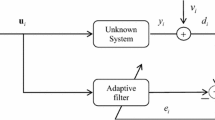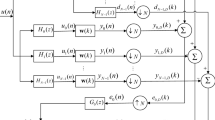Abstract
To overcome the performance degradation of adaptive filtering algorithms in the presence of impulsive noise, a novel normalized sign algorithm (NSA) based on a convex combination strategy, called NSA-NSA, is proposed in this paper. The proposed algorithm is capable of solving the conflicting requirement of fast convergence rate and low steady-state error for an individual NSA filter. To further improve the robustness to impulsive noises, a mixing parameter updating formula based on a sign cost function is derived. Moreover, a tracking weight transfer scheme of coefficients from a fast NSA filter to a slow NSA filter is proposed to speed up the convergence rate. The convergence behavior and performance of the new algorithm are verified by theoretical analysis and simulation studies.

















Similar content being viewed by others
Notes
The derivation of VSS-NSA, VSS-APSA, and NRMN is different from the original literatures, when input signal is the complex number. For paper length optimization, and in order to focus on the simplicity of the proposed approach, we have decided to only compare to NLMS-NSA algorithm.
References
J. Arenas-García, A.R. Figueiras-Vidal, A.H. Sayed, Mean-square performance of a convex combination of two adaptive filters. IEEE Trans. Signal Process. 54(3), 1078–1090 (2006). doi:10.1109/TSP.2005.863126
J. Arenas-Garcia, A.R. Figueiras-Vidal, Adaptive combination of normalised filters for robust system identification. Electron. Lett. 41(15), 874–875 (2005). doi:10.1049/el:20051936
J.A. Chambers, O. Tanrikulu, A.G. Constantinides, Least mean mixed-norm adaptive filtering. Electron. Lett. 30(19), 1574–1575 (1994). doi:10.1049/el:19941060
J. Chambers, A. Avlonitis, A robust mixed-norm adaptive filter algorithm. IEEE Signal Process. Lett. 4(2), 46–48 (1997). doi:10.1109/97.554469
S.C. Douglas, A family of normalized LMS algorithms. IEEE Signal Process. Lett. 1(3), 49–51 (1994). doi:10.1109/97.295321
S. C. Douglas, Analysis and implementation of the max-NLMS adaptive filter, in Proceedings on 29th Asilomar Conference on Signals, Systems, and Computers, pp. 659–663 (1995)
E. Eweda, Analysis and design of signed regressor LMS algorithm for stationary and nonstationary adaptive filtering with correlated Gaussian data. IEEE Trans. Circuits Syst. 37(11), 1367–1374 (1990). doi:10.1109/31.62411
S.B. Jebara, H. Besbes, Variable step size filtered sign algorithm for acoustic echo cancellation. Electronics Lett. 39(12), 936–938 (2003). doi:10.1049/el:20030583
B. E. Jun, D. J. Park, Y. W. Kim, Convergence analysis of sign-sign LMS algorithm for adaptive filters with correlated Gaussian data, in IEEE International Conference on Acoustics, Speech, and Signal Processing, pp. 1380–1383 (1995)
S. Koike, Variable step size normalized sign algorithm for fast convergent adaptive filters with robustness against impulsive noise. NEC Res. Dev. 41(3), 278–288 (2000)
S. Koike, Analysis of adaptive filters using normalized sign regressor LMS algorithm. IEEE Trans. Signal Process. 47(10), 2710–2723 (1999). doi:10.1109/78.790653
S. Koike, Convergence analysis of adaptive filters using normalized sign-sign algorithm. IEICE Trans. Fundam. Electron. Commun. Comput. Sci. E88–A(11), 3218–3224 (2006)
R.H. Kwong, E.W. Johnston, A variable step size LMS algorithm. IEEE Trans. Signal Process. 40(7), 1633–1642 (1992). doi:10.1109/78.143435
C.P. Kwong, Dual sign algorithm for adaptive filtering. IEEE Trans. Commun. 34(12), 1272–1275 (1986). doi:10.1109/TCOM.1986.1096490
L. Lu, H. Zhao, A novel convex combination of LMS adaptive filter for system identification, in 2014 12th International Conference on Signal Processing (ICSP), Hangzhou, pp. 225–229 (2014)
V.J. Mathews, Z. Xie, A stochastic gradient adaptive filter with gradient adaptive step size. IEEE Trans. Signal Process. 41(6), 2075–2087 (1993). doi:10.1109/78.218137
D. P. Mandic, E. V. Papoulis, C. G. Boukis, A normalized mixed-norm adaptive filtering algorithm robust under impulsive noise interference, in IEEE International Conference on Acoustics, Speech, and Signal Processing, pp. 333–336 (2003)
D.P. Mandic, NNGD algorithm for neural adaptive filters. Electronics Lett. 36(9), 845–846 (2000). doi:10.1049/el:20000631
D.P. Mandic, J.A. Chambers, Toward the optimal learning rate for backpropagation. Neural Process. Lett. 11(1), 1–5 (2000). doi:10.1023/A:1009686825582
D.P. Mandic, A.I. Hanna, M. Razaz, A normalized gradient descent algorithm for nonlinear adaptive filters using a gradient adaptive step size. IEEE Signal Process. Lett. 8(11), 295–297 (2001). doi:10.1109/97.969448
V.J. Mathews, S.H. Cho, Improved convergence analysis of stochastic gradient adaptive filters using the sign algorithm. IEEE Trans. Acoust. Speech Signal Process. 35(4), 450–454 (1987). doi:10.1109/TASSP.1987.1165167
V. H. Nascimento, R. C. de Lamare, A low-complexity strategy for speeding up the convergence of convex combinations of adaptive filters, in IEEE International Conference on Acoustics, Speech and Signal Processing, pp 3553–3556 (2012)
E.V. Papoulis, T. Stathaki, A normalized robust mixed-norm adaptive algorithm for system identification. IEEE Signal Process. Lett. 11(1), 56–59 (2004). doi:10.1109/LSP.2003.819353
D.I. Pazaitis, A.G. Constantinides, LMS+F algorithm. Electronics Lett. 31(17), 1423–1424 (1995). doi:10.1049/el:19951026
R. Price, A useful theorem for nonlinear devices having Gaussian inputs. IRE Trans. Inform. Theory 4(2), 69–72 (1958). doi:10.1109/TIT.1958.1057444
A.H. Sayed, Fundamentals of Adaptive Filtering (Wiley IEEE Press, New York, 2003)
T. Shao, Y. R. Zheng, J. Benesty, A variable step-size normalized sign algorithm for acoustic echo cancelation, in IEEE International Conference on Acoustics, Speech, and Signal Processing, pp. 333–336 (2010)
T. Shao, Y.R. Zheng, J. Benesty, An affine projection sign algorithm robust against impulsive interferences. IEEE Signal Process. Lett. 17(4), 327–330 (2010). doi:10.1109/LSP.2010.2040203
J. Shin, J. Yoo, P. Park, Variable step-size affine projection sign algorithm. Electronics Lett. 48(9), 483–485 (2012). doi:10.1049/el.2012.0751
J. Soo, K.K. Pang, A multi step size (MSS) frequency domain adaptive filter. IEEE Trans. Signal Process. 39(1), 115–121 (1991). doi:10.1109/78.80770
O. Tanrikulu, J.A. Chambers, Convergence and steady-state properties of the least-mean mixed-norm (LMMN) adaptive algorithm. IEE Proc. Vis. Image Signal Process. 143, 137–142 (1996)
P. Yuvapoositanon, J. Chambers, An adaptive step-size code-constrained minimum output energy receiver for nonstationary CDMA channels, in IEEE International Conference on Acoustics, Speech, and Signal Processing, pp. 465–468 (2003)
Acknowledgments
The authors want to express their deep thanks to the anonymous reviewers for many valuable comments which greatly helped to improve the quality of this work. This work was supported in part by National Natural Science Foundation of China (Grants: 61271340, 61571374, 61134002, 61433011, U1234203), the Sichuan Provincial Youth Science and Technology Fund (Grant: 2012JQ0046), and the Fundamental Research Funds for the Central Universities (Grant: SWJTU12CX026).
Author information
Authors and Affiliations
Corresponding author
Rights and permissions
About this article
Cite this article
Lu, L., Zhao, H., Li, K. et al. A Novel Normalized Sign Algorithm for System Identification Under Impulsive Noise Interference. Circuits Syst Signal Process 35, 3244–3265 (2016). https://doi.org/10.1007/s00034-015-0195-1
Received:
Revised:
Accepted:
Published:
Issue Date:
DOI: https://doi.org/10.1007/s00034-015-0195-1





